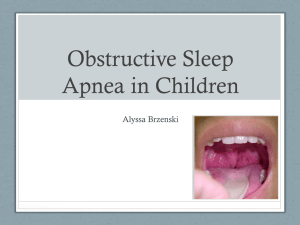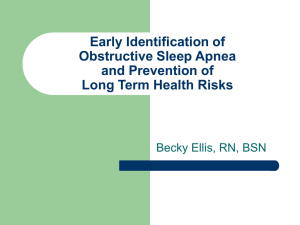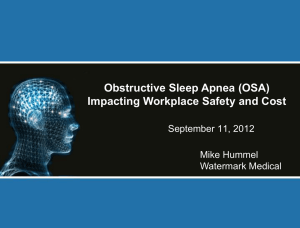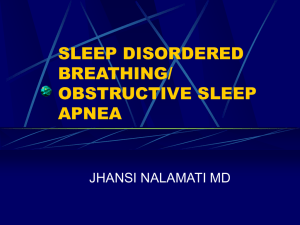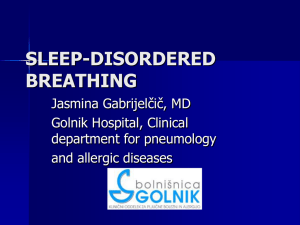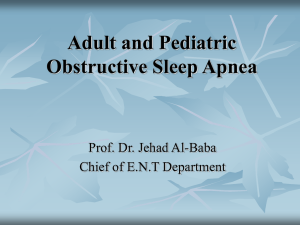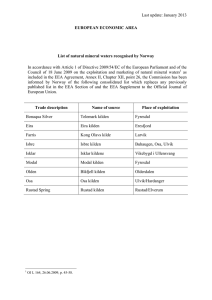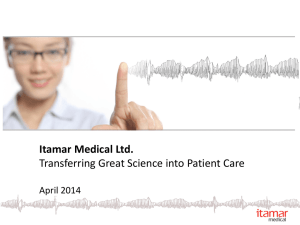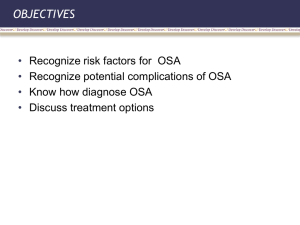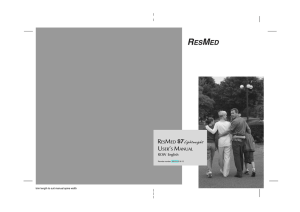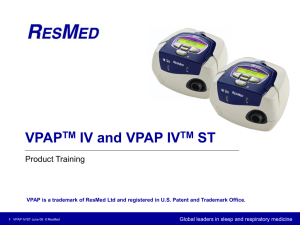Men vs. Women in Sleep-Disordered Breathing
advertisement
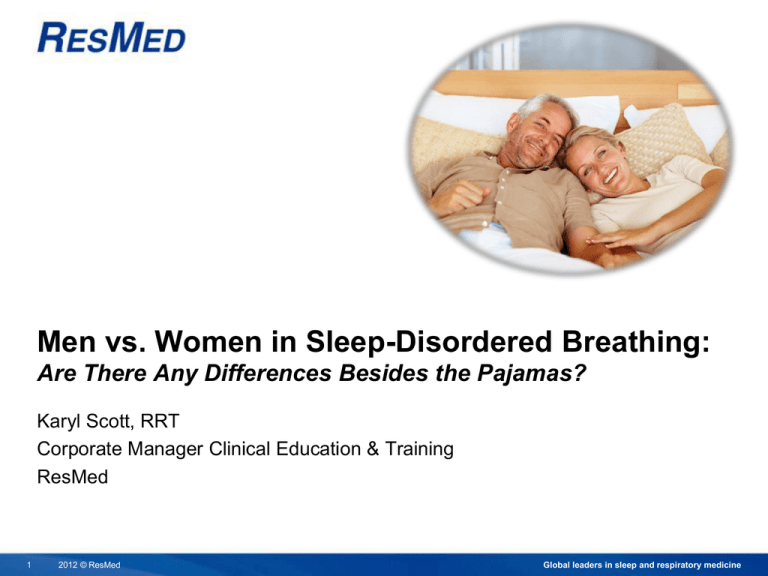
Men vs. Women in Sleep-Disordered Breathing: Are There Any Differences Besides the Pajamas? Karyl Scott, RRT Corporate Manager Clinical Education & Training ResMed 1 2012 © ResMed Global leaders in sleep and respiratory medicine Sleep Apnea Risk Factors Male Gender Obesity Family History of Sleep Problems Post-menopausal female Hypertension 2 2012 © ResMed Alcohol or Sedative Use Anatomic Abnormalities of the Upper Airway Endocrine & Metabolic Disorders OSA Indicators/Symptoms 3 Excessive daytime sleepiness Loud or frequent snoring Irregular breathing during sleep Morning headaches Heart failure Difficulty concentrating or memory loss Hypertension Obesity (BMI > 30) 2012 © ResMed Main Topics • Recognize the differences in sleep-disordered breathing (SDB/OSA) between men and women • Differentiate the symptoms of OSA between genders • Define different diseases and disease processes that may be at work with the female gender • Describe how the treatment might be different for females 4 2012 © ResMed Prevalence of SDB Obstructive Sleep Apnea (OSA) • • • • 4% of men, 2% of women (AHI >15) Most commonly diagnosed in 40-65 year olds 75–85% are undiagnosed Male to female ratio – 3:1 and 5:1 So . . . Why the difference in prevalence? • • • • 5 Symptoms are different Women more easily misdiagnosed Other disease states may affect OSA (vice versa) Young et al. found that when women did present with “typical” OSA symptoms, they were less likely to be referred to sleep clinics 2012 © ResMed Prevalence of SDB Obstructive Sleep Apnea (OSA) • • • • 4% of men, 2% of women (AHI >15) Most commonly diagnosed in 40-65 year olds 75–85% are undiagnosed Male to female ratio – 3:1 and 5:1 So . . . Why the difference in prevalence? • • • • 6 Symptoms are different Women more easily misdiagnosed Other disease states may affect OSA (vice versa) Young et al. found that when women did present with “typical” OSA symptoms, they were less likely to be referred to sleep clinics 2012 © ResMed Why is Prevalence Lower in Women? Men’s anatomy different – more vulnerable to upper airway collapse • Longer airways • Increased pharyngeal volume • Softer palate area Fat deposits differently in men • Airway • Upper body Respiratory control • Testosterone affects chemoreceptors • More testosteroneeasier to hit apneic threshold • Affects OSA, CSA and CompSA prevalence 7 2012 © ResMed Male vs. Female: What are the differences? Men Women ‘Typical’ OSA Symptoms: snoring, witnessed apneas, EDS Symptoms: Insomnia, fatigue, daytime tiredness, headaches, muscle pain Epworth Sleepiness Scale > 10 ESS – typically lower scores (have higher threshold for sleepiness) Severe OSA Less severe, more mild and UARS Obstructive apneas Large amounts of flow limitation/UARS More body position related (supine) Sleep stage related (mostly REM) CVD, Type 2 Diabetes, Stroke CVD, Type 2 Diabetes, stroke, dementia Higher AHI’s than women Lower AHI’s than men (more episodes of UARS) 8 2012 © ResMed Challenges in Improving the Diagnosis Rate Women have fewer obstructive apneas and obstructive hypopneas per hour 9 2012 © ResMed PSG shows: • More apneas in REM • Lower AHI total • May not meet insurance criteria for treatment of OSA Describe sleepiness as ‘general overall fatigue’ Symptoms typically are described as: • Insomnia • Depression • Hx of hypothyroidism • Morning headache Physician will go down other pathways first before OSA pathway Specific Medical Conditions Linked to Women 10 2012 © ResMed Global leaders in sleep and respiratory medicine Specific Medical Conditions In Women Pregnancy & Preeclampsia Hormones (Menstrual Cycle) SDB PCOS 11 2012 © ResMed Menopause Hormones – Protective? • Differing hormone levels a probably ‘culprit’ in explaining OSA between genders • Menstrual Cycle: – Sleep quality will change (may decrease pre-menstrual) – Hormone levels will change • Onset of menopause ‘turning point’ in prevalence in OSA – Heavily studied • High levels of progesterone or low levels of testosterone may be protective against OSA 12 2012 © ResMed Pregnancy and Sleep • Contributor to OSA prevalence in women • Substantial weight gain • Elevation of the diaphragm (↓FRC) • Mallampati score increases by 34% at 38 wks gestation – n= 242 – Secondary to fluid retention and edema – Upper airway narrow • Neck circumference enlarges • Nasal patency reduced • All of these factors suggest pregnancy may precipitate or exacerbate OSA 13 2012 © ResMed Snoring and Preeclampsia Habitual snoring: Best predictor of preeclampsia (Kryger) 14 2012 © ResMed Prevalence of snoring in women • Non-pregnant women 4% • Pregnant women 14-23% Snoring affects infant outcomes • When mom snores… • Infant smaller • Apgar is less than 7 at the 1 minute score Menopause • Sleep complaints increase as age increases – – – – Insomnia Hot flashes Mood disorders SDB • Prevalence of SDB – 3:1 ratio pre-menopause – 1:1 ratio post-menopause • OSA appears in post-menopause – Weight gain – Age – Reduction in estrogen (estrogen/progesterone seems to be a ‘protective’ mechanism) 15 2012 © ResMed Women with SDB: Why Should We Pay Special Attention to Them? 16 2012 © ResMed Global leaders in sleep and respiratory medicine Women with Sleep Apnea: Why Should we Pay Special Attention to Them? • Almost 40% of newly diagnosed sleep apnea patients are women1 • Risk of sleep apnea in women after menopause is equal to that of men2 • Related to higher risk of depression, high blood pressure and dementia3-5 • Baby boomers turning 65 around 2010 – Prevalence of sleep apnea in women peaks at 65 yrs – Men at 55 yrs • Surveys reveal that women have different therapy needs than men (TAS Polls) 1 Medicare and Private Payor Sleep Apnea Claims Data, 2009 2 Pickett et al. J Appl Physiol 1989 3 Hue et al. Am J Epidemiol 1999 4 Smith et al. Chest 2002 5 Yaffe et al. J Am Med Assoc 2011 18 2012 © ResMed
